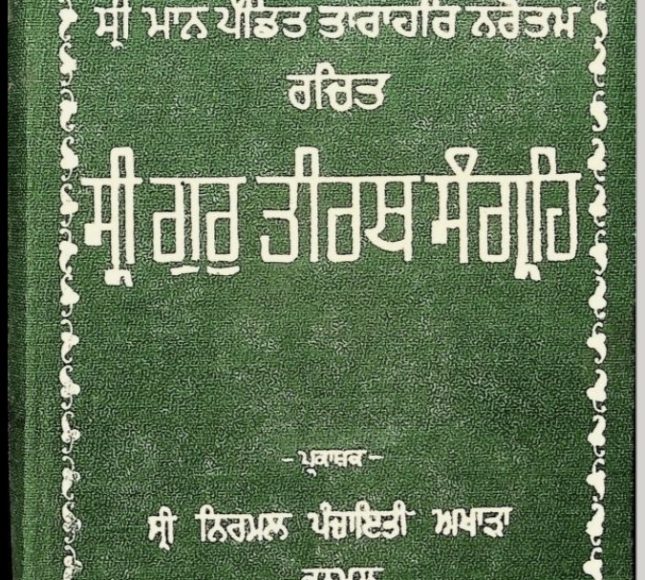SRI GUR TIRATH SANGRAHI (Sri = honoured; gur = Gurus of the Sikh faith; tirath = places of pilgrimage; sangrahi = collection) by Pandit Tara Singh Narotam lists places across the country hallowed by the visits of the Gurus and their families. The work, written in Gurmukhi script, was completed in 1940 Bk/AD 1883 and published by Bhai Buta Singh Pratap Singh, Amritsar. It is a pioneer work in this genre and gives the geographical location of each shrine, its religious and historical importance, and the name of the sect to which its principal priest or custodian at that time belonged.
In his Introduction to the book, the author stresses how important it was for a Sikh to visit these places of pilgrimage and what moral and spiritual benefits accrued from such visits. The first part of the book covers a total of 501 shrines, all in memory of the Gurus: 64 commemorating Guru Nanak, 7 Guru Angad, 11 Guru Amar Das, 9 Guru Ram Das, 33 Guru Arjan, 79 Guru Hargobind, 26 Guru Har Rai, 5 Guru Harkrishan, 100 Guru Tegh Bahadur, and 167 Guru Gobind Singh. This is followed by shrines in honour of the sons of the Gurus (pp. 167–190), the Gurus’ wives (pp. 191–218), and important Sikhs connected with the Gurus (pp. 219–231).
Then there are small sections—one each on Sikh relics and their location (pp. 232–235); the explanation of a verse by Guru Nanak (avan athatarai jani stanvai) (CG, 723) analysing it in the historical context (pp. 236–243); the Jathedars or leaders of the Sikh misls or chieftainship (pp. 243–249); and on how to proceed on a pilgrimage (pp. 249–272). To locate these places of Sikh sanctity, Tara Singh Narotam travelled extensively. The book carries the imprint of Tara Singh’s Nirmala orientation and countenances ideas and practices contrary to the Sikh tenets. One of the examples is his advocacy of the wearing of the janen, the sacred thread of the upper-caste Hindus, rejected by the Gurus.
References:
- Shergill, Surindar Singh, Pandit Tara Singh Narotam: Jivan te Rachna. Patiala, 1985
- Narotam, Tara Singh, Sri Gur Tirath Sangrahi. Kankhal, 1975
Historical and Cultural Context
Sri Gur Tirath Sangrahi was completed in 1940 Bk (AD 1883) and published in Amritsar by Bhai Buta Singh Pratap Singh. Written in the Gurmukhi script, the work reflects the rich cultural past where pilgrimage, or tirath yatra, was seen as an essential component of Sikh devotional practice. Pandit Tara Singh Narotam, an erudite scholar and traveler, undertook extensive journeys across the country in search of these sacred sites. He not only recorded their geographical locations but also provided detailed accounts of each shrine’s religious and historical significance.
The text is significant because it forms one of the earliest systematic attempts to catalogue Sikh pilgrimage sites. For a community rooted in both historical memory and spiritual continuity, such a work serves as a guide to connect personal piety with collective heritage. In his introduction, Narotam emphasizes that visits to these sacred places are not merely geographical journeys; they are moral and spiritual exercises through which devotees can dispel ignorance and recharge their faith.
Structure and Content
Sri Gur Tirath Sangrahi is meticulously organized into several thematic sections:
- Shrines Associated with the Gurus:
The primary portion of the work lists 501 shrines. These include:
64 commemorating Guru Nanak, the founder of Sikhism.
7 for Guru Angad.
11 for Guru Amar Das.
9 for Guru Ram Das.
33 for Guru Arjan.
79 for Guru Hargobind.
26 for Guru Har Rai.
5 for Guru Harkrishan.
100 for Guru Tegh Bahadur.
167 for Guru Gobind Singh. This extensive enumeration not only highlights the profound reverence for the Gurus but also provides a geographical and numerical framework for Sikh sacred spaces. - Family and Key Personalities:
Following the shrine listings for the Gurus, the text covers:
Shrines in honor of the sons of the Gurus.
Shrines dedicated to the Gurus’ wives.
Shrines commemorating other important Sikh personalities who were connected with the Gurus. These sections enrich the narrative by broadening the scope of sanctity beyond the canonical figures, capturing the collective memory of community and kinship. - Additional Sections:
The latter segments of the work tackle various thematic aspects:
Sikh Relics and Their Locations: A brief but significant inventory of sacred objects and relics.
Exegetical Analysis: An example is provided through the explanation of a verse by Guru Nanak (avan athatarai jani stanvai), which is analyzed within its historical context.
Sikh Leadership: Discussions on the Jathedars or leaders of the Sikh misls, offering insights into the administrative and martial legacy of the community.
Guidelines for Pilgrimage: Detailed instructions on how to spiritually and logistically approach a pilgrimage, thereby functioning as a practical manual for devotees.
Each section is carefully paginated—the shrines and relics are assigned specific page ranges—and the work, taken as a whole, reflects the enormous effort by Narotam to document and systematize Sikh pilgrimage sites.
Literary Style and Scholarly Impact
Sri Gur Tirath Sangrahi is marked by its clear descriptive style and detailed reporting. Although its approach is primarily geographical and historical, the work is imbued with a devotional fervor. Narotam’s narrative underscores the moral and spiritual benefits that accrue from visiting these sacred sites—a central tenet of Sikh pilgrimage practice.
There is, however, an interesting scholarly nuance: while the text is deeply rooted in authentic geographical and historical data, it also reveals the author’s Nirmala orientation. For example, his advocacy for certain practices, such as the wearing of the janeu (a sacred thread of the uppercaste Hindus) that was later rejected by the Gurus, hints at a syncretism that was common among early Sikh scholars. Nevertheless, despite these occasional departures, the work remains a cornerstone in the genre of pilgrimage literature.



